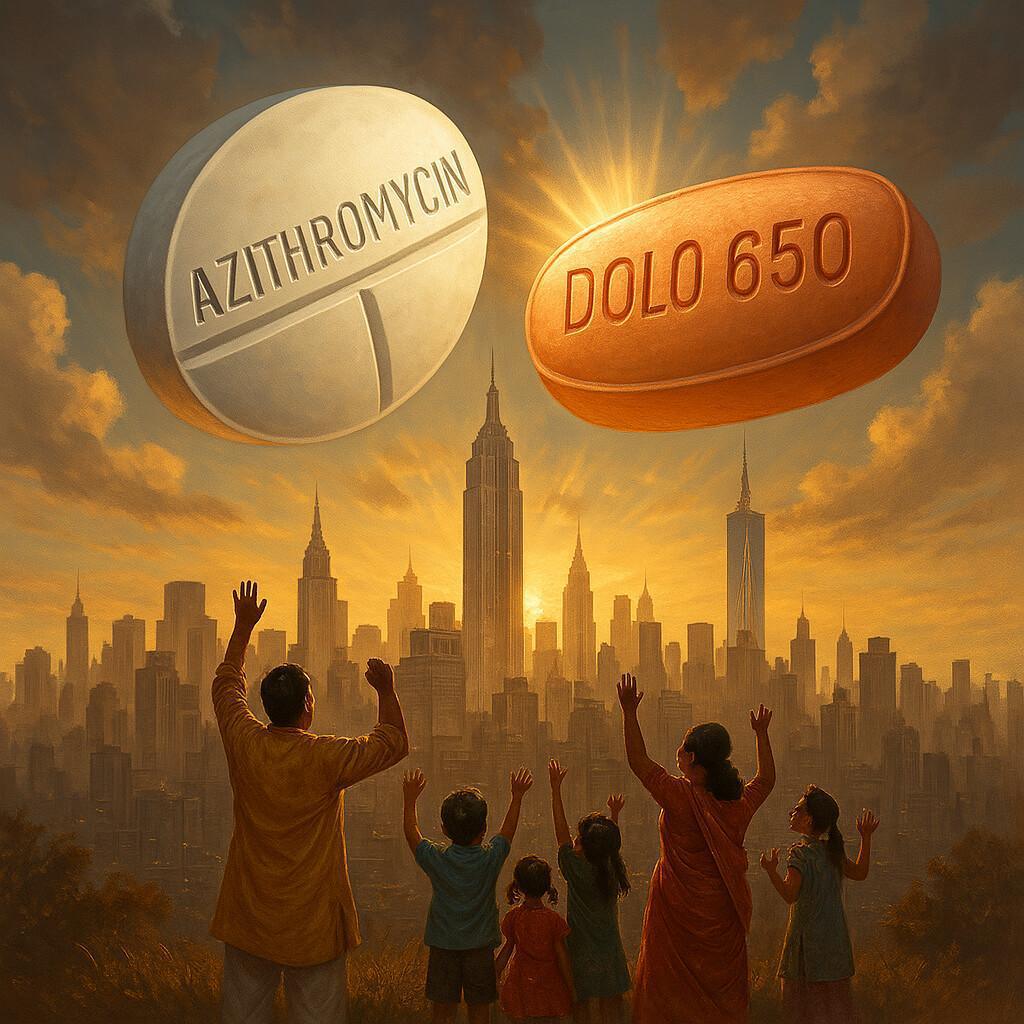Santhosh was on a Zoom call with his college buddy Rohan, now living in Texas, when the inevitable question came up:
“Bro, when are you going to India next? Can you bring me some Dolo 650 and Azithro?”
It wasn’t the first time.
Over the years, Santhosh’s suitcase had transformed into a mobile desi pharmacy—stocked not with souvenirs, but with strips of Azithromycin, Dolo 650, Hajmola, and yes, even chyawanprash. And he's not alone.
For thousands of Indians living in the U.S., Azithromycin and Dolo 650 are more than just pills—they're a piece of home. A warm memory of being wrapped in a blanket, sipping chai, and having your mom hand you the “magic tablet.” In a foreign land of Tylenol, Z-Packs, and CVS receipts, these Indian favorites carry a different kind of healing.
Let’s unpack this uniquely desi obsession with two tiny pills—and why they’ve earned VIP status in Indian-American households.
💊 Azithromycin: The Trusty Superhero
1. 🇮🇳 The “Z-Pack” with an Indian Twist
In India, Azithromycin is the antibiotic equivalent of cutting chai—widely available, widely loved. It’s the go-to fix for everything from sore throats to sinus infections. And unlike in the U.S., where you need a prescription, in India you can literally walk into any chemist and get it, no questions asked.
📊 In 2019, Indians consumed over 500 crore antibiotic tablets, with Azithro leading the list.
No wonder Indians treat it like medicine gold when flying back from home.
2. ⏳ The 3-Day Miracle
Azithromycin doesn’t believe in wasting time. While most antibiotics stretch out for 7–10 days, Azithro wraps up its business in just 3 to 5 days.
For Indian-Americans juggling grad school, H-1B stress, full-time jobs, and sub-zero winters, that’s a blessing in blister-pack form.
🗣️ “Why take a week off when three days can fix it?” laughs Priya, a software engineer in Seattle.
3. 📲 WhatsApp Medicine Culture
Indians trust their doctors—but they trust their WhatsApp groups just a bit more. If someone’s cousin in California says Azithro cured their cold in two days, that screenshot goes viral across friend circles.
🙋♂️ Santhosh’s “Suitcase Pharmacy”
“When I first moved to Chicago,” says Santhosh, “my mom packed 10 strips of Azithromycin. I thought she was being dramatic. But when a brutal Midwest cold knocked me out, NyQuil did nothing. My Indian roommate gave me Azithro—and I was back to normal in two days. That’s when I understood.”
💥 Dolo 650: The Magic Pill with Emotional Baggage
1. 💪 The “Indian Tylenol” That Packs a Punch
Dolo 650 contains 650mg of paracetamol—stronger than the standard 500mg acetaminophen you’ll find in most U.S. pharmacies. For Indians used to this extra strength, anything less feels like a downgrade.
🗣️ “Why settle for 500mg when 650 exists?” quips Anjali, who always brings back a Dolo stash from her India visits.
2. 🏠 Comfort in a Strip
For many, Dolo isn’t just medicine—it’s muscle memory.
Whether it was post-exam exhaustion, a wedding hangover, or monsoon-season fevers, Dolo was always there. So when Indians move abroad, it becomes part of their emotional luggage.
🗣️ “When I take Dolo, I feel like my mom’s looking after me,” says Riya, a nurse in Boston.
3. 💵 Cost & Convenience
In India, a strip of Dolo costs about ₹25–₹30 (less than 50 cents). In the U.S., generic acetaminophen feels expensive—and oddly ineffective by comparison. And thanks to desi grocery stores (and a few “under-the-counter” arrangements), Dolo is surprisingly easy to find.
🙋♀️ Anjali’s Winter Epiphany
Anjali moved to New York full of confidence—until her first American winter hit. Bedridden with fever, she tried Advil and Tylenol, but nothing worked. In desperation, she reached into her "India stash" and popped a Dolo 650.
“Within hours, the fever broke. I finally understood the hype.”
📚 Quick Bites: Fun Facts & History
Azithromycin
-
Discovered in 1980 by a team in Croatia; licensed to Pfizer as Zithromax.
-
Overuse in India has led to concerns around antibiotic resistance.
-
Known as the “3-day savior” in Indian homes.
Dolo 650
-
The COVID-era MVP in India—prescribed like water during the pandemic.
-
Became a household name, trending on Twitter during peak COVID waves.
-
Still widely preferred by Indians over American brands like Tylenol.
🧳 Conclusion: Medicine, Memory & Motherland
For Indian immigrants, Azithromycin and Dolo 650 aren’t just tablets—they're time machines.
They take you back to rainy school days, cozy blankets, and a steaming cup of haldi doodh. They remind you of parents who cared, of a healthcare system you understood, and of home remedies that always seemed to work.
In a land of co-pays and cold pharmacies, they are warmth, trust, and familiarity rolled into a silver strip.
🗣️ “It’s like carrying your mom’s home remedies in your wallet,” says Santhosh. “You might not always need it—but just knowing it’s there makes you feel safe.”
So next time your Indian friend visits home, don’t be surprised if their luggage is heavier on the return flight. It’s not just the pickles and papads—it’s a little slice of home wrapped in foil, ready to heal with nostalgia.


